Final report for ONC21-091
Project Information
Seed Savers Exchange (IA) has partnered with eight Native farmers at eight distinct sites in Iowa, Minnesota, Wisconsin, and Michigan to regenerate regional varieties from seed we researched and believed to have Indigenous origins. This project grew out of the successes and lessons learned from the 2020 partnership funded by NC-SARE, and the acknowledgement that more farmers sharing knowledge, growing varieties, and saving seeds at more sites builds greater resilience against weather and other factors that may impact the growing season. In the instance where multiple partners were growing the same variety, more partner sites also helped identify varietal performance across a greater geographic area and under different environmental conditions (within short northern midwest growing seasons). Combining in-field observation with the strong knowledge-sharing and relationship building that has occurred over the course of this project has already helped realize success toward a project goal to strengthen and sustain food sovereignty and climate adaptability in Indigenous communities.
The partners are geographically diverse and we anticipated that COVID-19 might continue to present challenges. To address these factors, we are sharing the knowledge and experiences of project partners through a series of four virtual, educational webinars that are highlighting our partners, the varieties they chose, and their approaches to Indigenous agriculture, seedkeeping, and integration of land/habitat conservation for a broad audience of growers, farmers, and others. One of the 2020 seed rematriation partners, Shelley Buffalo, is moderating the webinars. Through 2/23/22, we have conducted two of the four webinars. The third will be on March 1 and the fourth will be on March 9, 2022. The well-publicized and well-attended forums are being recorded and stored on the Seed Savers Exchange YouTube channel (SSEHeritageFarm) for continued application after the initial live broadcast.
- Grow and evaluate 10-15 (actual: 12) Indigenous crop varieties at Seed Savers Exchange and approximately 40 (actual: 45) varieties at partner sites
- Share and demonstrate organic growing, corn and squash hand pollination, and other planting/growing/harvesting/seed saving techniques among partners
- Use virtual forums to educate key audiences and a broader segment of the public
- Increase knowledge of Indigenous foodways and land management practices among both Indigenous and non-Indigenous communities
- Support Indigenous agricultural sustainability, food access, and economic opportunity through rematriation of Indigenous varieties
- Ensure adequate seed inventory in the SSE seed bank for long-term preservation
- Ensure that varieties can be grown again and stewarded in the communities in which they were originally grown
Cooperators
Research
The 2021 process used by Seed Savers Exchange (SSE) and our Indigenous partners is based on the seed rematriation model developed by the Indigenous Seed Keepers Network of the Native American Food Sovereignty Alliance and the participatory conservation model used in the 2020 partnership. In these models, Indigenous seeds are identified, grown, and harvested in partnership with their communities of origin.
The ultimate goal of seed rematriation partnerships is for Indigenous communities to be able to access seeds that help them build and sustain their capacity to grow and steward their own seed supply that in turn builds seed and food sovereignty. In 2020 and 2021, Seed Savers Exchange’s model used a participatory conservation approach with regular, frequent communication and collaboration, one in which ALL partners (including SSE) grew from seed, evaluated varieties, and saved seeds for both preservation and sharing with Indigenous communities.
A critical component of this work is the full, active partnership with all partners selecting the seeds they wanted to grow from the Seed Savers Exchange seed bank as well as sharing resources, methods, and knowledge around growing, pollinating, seed harvesting and processing, seed saving, and the histories of the seeds. As administrator of the SARE grant, SSE shared seeds and provided supplies like cover crops, fish emulsion, and cattle panels to grow beans. SSE also convened partner meetings and check-ins throughout the year, and is managing all technical aspects and facilitating promotion of the webinars.
The first step was sharing a list of seeds in the SSE seed bank collection with potential Indigenous origin. The seeds were selected by the partners based on variety name, description, and their potential histories. Seeds sometimes come into the collection with names that might not truly reflect their origins, or with incomplete stewardship histories, so in a few cases the seeds have needed to be grown and the varieties evaluated for positive identification. This project has been instrumental in helping to accurately identify seeds with Indigenous origins, as well as helping to rename and improve the documented stewardship histories for varieties in the SSE collection.
During the growing season, this participatory, collaborative model provided an opportunity to work with both traditional Indigenous and more modern seed growing and saving practices, with each partner choosing and combining the methods that worked best for them. (These methods included cover crops, fish emulsion fertilizer, planting mound gardens as well as planting in rows, interplanting crops, and corn hand-pollination.)
At monthly check-ins, all partners shared successes and challenges, working together to address any issues. They have compared notes about varieties multiple partners are growing at multiple sites. They are also sharing yield results and strategies for processing and saving seeds as well as disbursing seeds into their communities through crop cooperatives and seed steward networks.
The seeds chosen by the partners have for the most part been varieties of which SSE has more than adequate inventory in the seed bank, so that most of the seed resulting from the 2021 grow outs could be saved by the partners to share with their networks and grown by them again in 2022 and beyond. We are carefully ensuring that there continues to be enough seed securely stewarded in the SSE collection for future needs while also ensuring that partners are able to build seed saving knowledge, seed supply, and seed sovereignty in their communities. The ultimate goal of the partnership is to bring ancestral seeds home to their Indigenous families who will grow and share more seeds, and so on, to build local food sovereignty programs and networks.
2020 and 2021 Seed Rematriation Supplies - 2021
2020 and 2021 Seed Rematriation Varieties for SARE Report - 2021
Field notes are still being gathered from partners and will be shared with the final report on this grant.
Educational & Outreach Activities
Participation Summary:
Sowing The Three Sisters (article from Heritage Farm Companion, p18)
Rematriation Graphic Notes by Kristin
SSE and the project partners conducted a four-part webinar series highlighting the project, Welcoming Seeds Home which had 7,105 registered participants and has a total of 10,454 views! 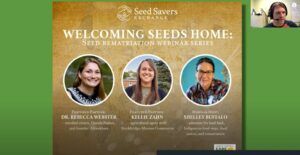
Partners have also been featured on numerous podcasts (and partner Shiloh Maples has even started her own podcast, ‘Spirit Plate’), and SSE preservation director Philip Kauth also presented to the Great Plains Grower Conference in January.
In addition, the project partners are all developing the stewardship networks and community education needed for these seeds to truly be rematriated within their communities. Jessika Greendeer is sharing knowledge and seeds with others through the work of Dream of Wild Health, Becky Webster is continuing her successful bean cooperative begun as part of the 2020 partnership, Kellie Zahn is sharing knowledge and seeds through initiatives of the Stockbridge-Munsee community, Luke Kapayou is sharing knowledge and seeds with new growers and seed keepers in the Meskwaki community, Shiloh Maples is working to formalize a Native Farmer Seed Share Program with Indigenous Seed Keepers Network, etc.
These seed stewardship chains and educational mentoring networks are a critical component of the long-term success of the seed rematriation work, as Indigenous communities continue to rebuild seed and food security and sovereignty.
Seed Savers Exchange shared an article in our quarterly membership magazine, the Heritage Farm Companion, and featured Dr. Rebecca Webster in the article, Sowing The Three Sisters which is shared with more than 8,000 by email and direct mailed magazines.
Seed Savers Exchange also planned and facilitated a culminating field day which was hosted at Ukwakhwa, the nonprofit Oneida farm of Dr. Rebecca Webster. The goal of the field day was to gather Seed Rematriation farm partners in person and celebrate with a day of shared learning, food, and an open conversation about where the Seed Rematriation partnership could lead next. Below include photos from the event. Kristin Eggen, an SSE staff member, is a talented graphic recorder and created the agenda below and notes throughout the field day that were shared with partners after. Approximately 25 people enjoyed a day together around learning, food, and seed. An article about the field day will be shared in the next edition of the Hertiage Farm Companion which will be shared with 8,000+ members both digitally and in print.
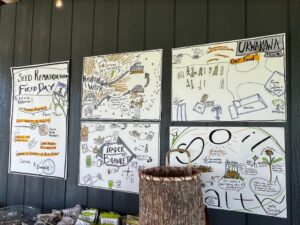 |
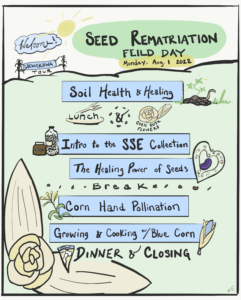 |
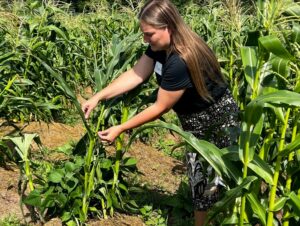 |
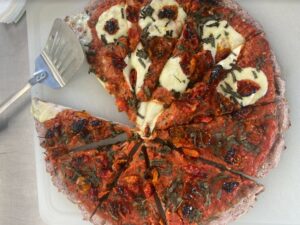 |
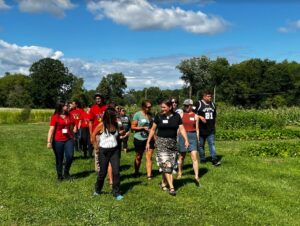 |
|
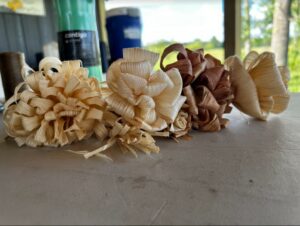 |
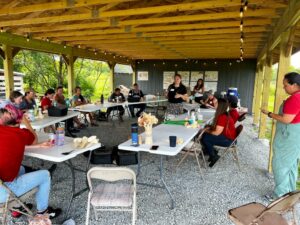 |
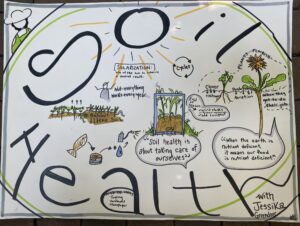 |
Learning Outcomes
Project Outcomes
This project is one of the steps being taken by Indigenous nations and communities to enhance their food security and food sovereignty, and Seed Savers Exchange believes that ensuring access to the seed resources within the Seed Savers Exchange seed bank collection directly fulfills both a key project goal and our mission. Seed sovereignty is connected to food sovereignty, and in order for Indigenous communities to form robust local food programs, they need seeds to grow and share. There is other seed rematriation work happening around the country (and the world, referred to in some places as seed repatriation) and the participatory conservation model that SSE and the 2020 project partners collaboratively developed is being shared broadly for use by others.
Seed sharing and knowledge building among project partners has rippled into their communities. While this was definitely another learning year, confidence has increased for all project partners to grow, save, and share seeds as well as successfully teach their communities to do the same.
In regard to the three specific project outcomes identified in the grant application, impact to date is as follows:
Planned Outcome 1: SSE and eight farmer partners gain knowledge of diverse sustainable and Indigenous agricultural processes, methods and techniques. Measured by comparing pre-project knowledge with post-project knowledge.
Actual Impact 1: SSE and eight farmer partners have been able to choose among a number of methods to implement the practices that work best for their situations and values, and have additional knowledge to draw on as circumstances change.
Planned Outcome 2: Adequate inventory of seeds from approximately 50 chosen crop varieties (with histories and varietal information including evaluations from grow outs) are returned (rematriated) to at least eight Indigenous communities, so that they can grow crops in the following year. Measured by the number of varieties grown and the seed inventory able to be rematriated.
Actual Impact 2: Partner communities have increased seed stock quantity for 45 varieties (and SSE has increased seed stock for an additional 12 varieties), enhancing their ability to sustainably grow these crops for themselves (increasing access to healthy food and food sovereignty) and, if they choose, for commerce.
Planned Outcome 3: Virtual forum attendees learn about Indigenous foodways and seed-to-seed production of rare and endangered varieties. Measured by post-forum surveys, and conversations with attendees.
Actual Impact 3: The virtual forums were a huge success and were the most highly attended virtual event to date at Seed Savers Exchange. While post forum survey's were not used, success was measured by outreach, which included 7,000+ registered attendees and 10,000+ views on YouTube. Each session was interactive with the audience making time for questions and answers.
The opportunity for the partners to welcome the seeds home, and to learn from them about how and where they want to grow, has been a meaningful measure of success. Identifying seeds in the Seed Savers Exchange Collections and returning seeds home to their tribes of origin has been a meaningful process. One farmer from the Meskwaki Nation in Marshalltown, Iowa shared how much it helped to be connected with other indigenous farmers not only to share information and seed, but for moral support as well. During the Seed Rematriation Field Day in August of 2022, conversations were lively on how the relationships established as part of this project could continue to bloom into the future.
The following recommendations arose from the project in 2021.
- Discussions are happening in Native/Indigenous communities around data sovereignty (what information is appropriate to share and with whom). The webinars have also touched on the discussion around who has the rights to grow Indigenous varieties. Respecting and listening to Indigenous voices in these conversations feels very important to staff at SSE.
- An area that would be interesting to explore further is the concept of the community and support system that developed from the two years of this grant-funded project. These aspects of the project will continue long after the funding has ended, and are named by all partners as a critical outcome of this work.